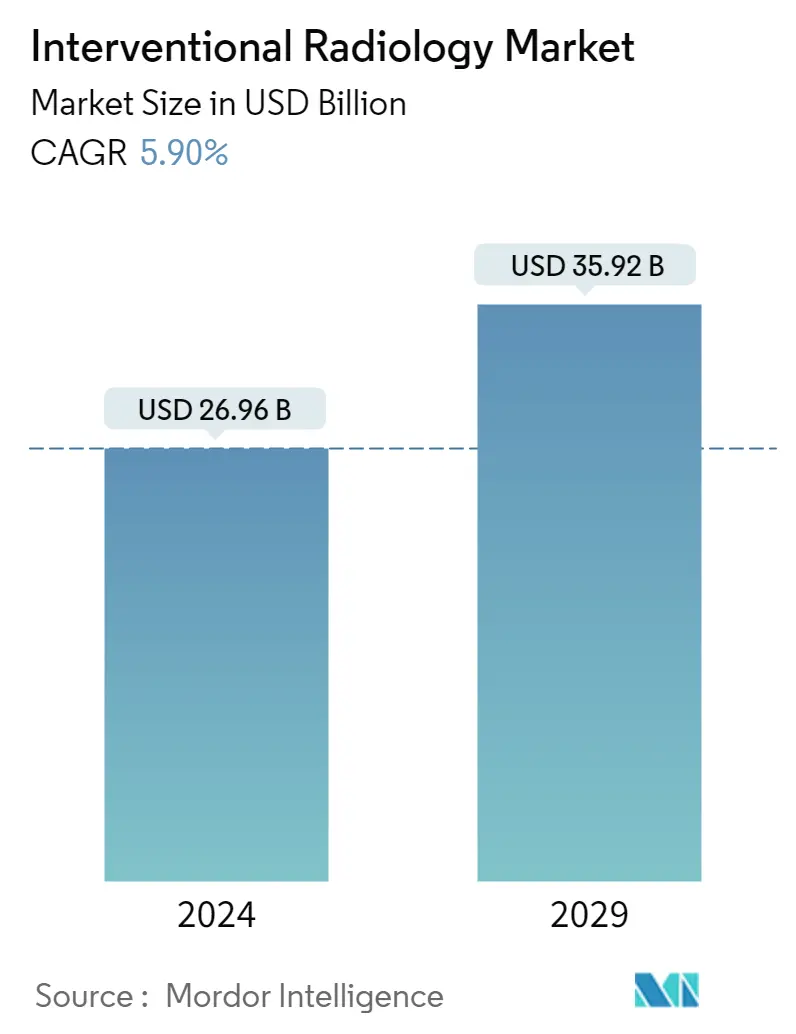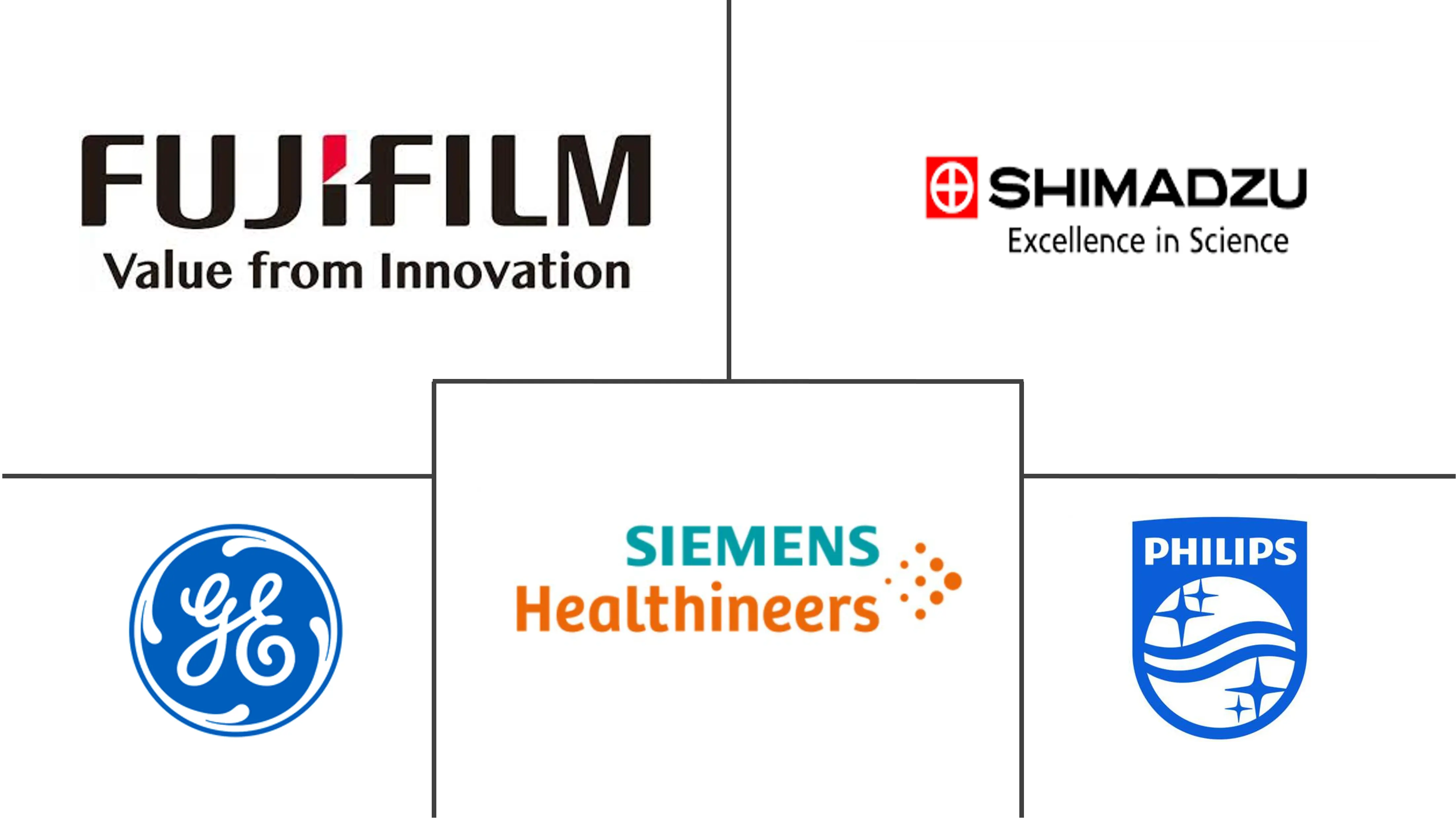Market Size of Interventional Radiology Industry

| Study Period | 2021 - 2029 |
| Market Size (2024) | USD 26.96 Billion |
| Market Size (2029) | USD 35.92 Billion |
| CAGR (2024 - 2029) | 5.90 % |
| Fastest Growing Market | Asia Pacific |
| Largest Market | North America |
Major Players
*Disclaimer: Major Players sorted in no particular order |
Interventional Radiology Market Analysis
The Interventional Radiology Market size is estimated at USD 26.96 billion in 2024, and is expected to reach USD 35.92 billion by 2029, growing at a CAGR of 5.90% during the forecast period (2024-2029).
COVID-19 had an impact on the interventional radiology market initially, as hospital and healthcare services were significantly reduced due to social distancing measures taken by governments across the world. For instance, according to an article published by PubMed Central in October 2021, the pandemic dramatically impacted service delivery in many radiology departments across the world. Hence, the pandemic had a significant impact on the market in its initial phase. As the pandemic has subsided and the lockdown restrictions are withdrawn by all countries, the market studied is expected to have stable growth during the forecast period.
The driving factor of the market is the rising trend of minimally-invasive procedures, owing to the cost-effective solutions and lesser hospital stays. With the help of minimally invasive techniques, patients are treated quickly and are usually discharged from the hospital on the same day. Most of these processes require imaging technology.
Innovations in imaging technologies, which provide real-time images to surgeons to show a comprehensive view of internal organs while diagnosing, are driving the interventional radiology market. The major fields of advancement are augmented reality and artificial intelligence. In contrast to virtual reality, where the field of vision for doctors includes no real images, augmented reality offers the ability to move objects (scopes and devices) inside the body and interact with its surroundings. This dynamic development has a variety of applications for image-led interventions. Artificial intelligence uses complex algorithms to detect abnormalities and anomalies in medical images, like CT scans and X-rays. For instance, according to an article published by PubMed Central in February 2022, the implementation of artificial intelligence in diagnostic and interventional radiology may help improve image analysis, aid in diagnosis, and suggest appropriate interventions, clinical predictive modeling, and trainee education, among others.
Chronic diseases persist, often for illnesses or chronic conditions such as heart disease, asthma, cancer, and diabetes. Heart disease is one of the leading causes of death across the world. Until years ago, the treatment for heart disease meant opening a patient's chest to enter directly into the heart with surgery, which was expensive and often exposed the patient to a high risk of infection.
According to the data published by the American Cancer Society in 2022, there will be an estimated 1.9 million new cancer cases diagnosed and 609,360 cancer deaths in the United States in 2022. The high incidence of cancer cases in countries with higher standards of living is primarily due to the availability and access to better diagnostic procedures. Interventional radiology equipment, like CT scanners and MRI systems, are used extensively for these procedures, due to which their demand is expected to increase.
Therefore, owing to the aforementioned factors, the market studied is anticipated to witness growth over the forecast period. However, the risk of high radiation exposure and the high cost of equipment is expected to hinder the growth of the market.
Interventional Radiology Industry Segmentation
As per the scope of the report, interventional radiology is the use of radiological image guidance (X-ray fluoroscopy, ultrasound, computed tomography [CT], or magnetic resonance imaging [MRI]) to precisely target the therapy. Most of the treatments that fall under IR are minimally invasive surgeries and the alternatives for open or laparoscopic (keyhole) surgery.
The Interventional Radiology Market is segmented by Product (MRI Systems, Ultrasound Imaging Systems, CT Scanners, Angiography Systems, Fluoroscopy Systems, Biopsy Devices, and Other Products), Application (Cardiology, Urology and Nephrology, Oncology, Gastroenterology, and Other Applications), and Geography (North America, Europe, Asia-Pacific, Middle East and Africa, and South America). The market report also covers the estimated market sizes and trends for 17 different countries across the world. The report offers the value (in USD million) for all the above segments.
| By Product | |
| MRI Systems | |
| Ultrasound Imaging Systems | |
| CT Scanners | |
| Angiography Systems | |
| Fluoroscopy Systems | |
| Biopsy Devices | |
| Other Products |
| By Application | |
| Cardiology | |
| Urology and Nephrology | |
| Oncology | |
| Gastroenterology | |
| Other Applications |
| Geography | ||||||||
| ||||||||
| ||||||||
| ||||||||
| ||||||||
|
Interventional Radiology Market Size Summary
The interventional radiology market is poised for significant growth over the forecast period, driven by the increasing adoption of minimally invasive procedures and advancements in imaging technologies. The market's expansion is supported by the rising demand for cost-effective solutions that reduce hospital stays and enhance patient recovery times. Innovations in augmented reality and artificial intelligence are transforming the landscape, providing real-time imaging that improves diagnostic accuracy and treatment outcomes. These technologies are particularly beneficial in managing chronic diseases such as cancer and cardiovascular disorders, where early detection and precise interventions are crucial. Despite initial setbacks due to the COVID-19 pandemic, the market is expected to stabilize and grow as healthcare services resume normal operations.
The market's growth is further bolstered by the high prevalence of chronic conditions and the increasing need for less invasive treatment options. In the United States, the demand for interventional radiology procedures is fueled by the rising incidence of heart disease and cancer, necessitating advanced diagnostic and therapeutic interventions. The introduction of new products and technologies by leading companies, such as Siemens Healthineers and Philips, is expected to enhance market dynamics. However, challenges such as high radiation exposure and equipment costs may impede growth. The market remains highly competitive, with both global and local players vying for market share, indicating a fragmented landscape with potential opportunities for smaller companies to enter and innovate.
Interventional Radiology Market Size - Table of Contents
-
1. MARKET DYNAMICS
-
1.1 Market Overview
-
1.2 Market Drivers
-
1.2.1 Increasing Burden of Chronic Diseases
-
1.2.2 Technological Advancements in Interventional Radiology Devices
-
-
1.3 Market Restraints
-
1.3.1 Risk of High Radiation Exposure
-
1.3.2 High Cost of Equipment
-
-
1.4 Porter's Five Forces Analysis
-
1.4.1 Threat of New Entrants
-
1.4.2 Bargaining Power of Buyers/Consumers
-
1.4.3 Bargaining Power of Suppliers
-
1.4.4 Threat of Substitute Products
-
1.4.5 Intensity of Competitive Rivalry
-
-
-
2. MARKET SEGMENTATION (Market Size by Value - USD million)
-
2.1 By Product
-
2.1.1 MRI Systems
-
2.1.2 Ultrasound Imaging Systems
-
2.1.3 CT Scanners
-
2.1.4 Angiography Systems
-
2.1.5 Fluoroscopy Systems
-
2.1.6 Biopsy Devices
-
2.1.7 Other Products
-
-
2.2 By Application
-
2.2.1 Cardiology
-
2.2.2 Urology and Nephrology
-
2.2.3 Oncology
-
2.2.4 Gastroenterology
-
2.2.5 Other Applications
-
-
2.3 Geography
-
2.3.1 North America
-
2.3.1.1 United States
-
2.3.1.2 Canada
-
2.3.1.3 Mexico
-
-
2.3.2 Europe
-
2.3.2.1 Germany
-
2.3.2.2 United Kingdom
-
2.3.2.3 France
-
2.3.2.4 Italy
-
2.3.2.5 Spain
-
2.3.2.6 Rest of Europe
-
-
2.3.3 Asia-Pacific
-
2.3.3.1 China
-
2.3.3.2 Japan
-
2.3.3.3 India
-
2.3.3.4 Australia
-
2.3.3.5 South Korea
-
2.3.3.6 Rest of Asia-Pacific
-
-
2.3.4 Middle East and Africa
-
2.3.4.1 GCC
-
2.3.4.2 South Africa
-
2.3.4.3 Rest of Middle East and Africa
-
-
2.3.5 South America
-
2.3.5.1 Brazil
-
2.3.5.2 Argentina
-
2.3.5.3 Rest of South America
-
-
-
Interventional Radiology Market Size FAQs
How big is the Interventional Radiology Market?
The Interventional Radiology Market size is expected to reach USD 26.96 billion in 2024 and grow at a CAGR of 5.90% to reach USD 35.92 billion by 2029.
What is the current Interventional Radiology Market size?
In 2024, the Interventional Radiology Market size is expected to reach USD 26.96 billion.

